After intense flooding, Barcelona is still battling drought
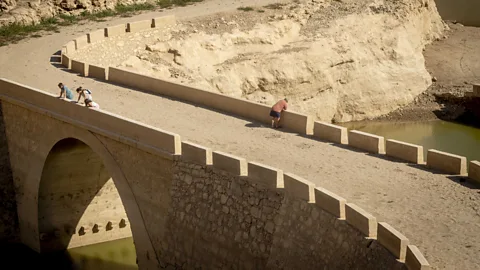 Getty Images
Getty ImagesAs climate change makes rainfall more intense and infrequent, Catalonia's authorities face the task of providing water security and drinking water to millions.
Barcelona's Parc de Joan Miró covers four city blocks on the edge of the Eixample district, a dusty square dotted with palm trees, pink blushed bougainvillea, and a tall brightly coloured pillar titled Dona i Ocell ("woman and bird"), designed by the Catalan artist.
After several years of drought, it's dustier than ever. The shallow fountains have been drained, and the city has even taken to chopping down wilting palm trees before they can topple over. In eastern Catalonia, the three years from 2021-23 had some of the worst drought in recorded history.
But at certain points through winter 2024, beneath the park, a huge cistern 17m (58ft) deep becomes filled with cloudy rainwater. These are the two extremes the city finds itself in, where there can be too much water and still not enough.
"We are suffering this severe drought, and at the same time we are suffering some results of extreme precipitation," says Marc Prohom, head of climatology at the Meteorological Service of Catalonia.
After three years of dry conditions, Catalonia's authorities announced a drought emergency early in 2024, which lasted for several months. In early 2025, low water reserves mean the city and most of the surrounding area were under an alert for drought.
Households were restricted to 200 litres (53 gallons) of water a day – less than a typical bathtub. Using tap water to water gardens, fill pools, or wash cars was forbidden under threat of fines. Hundreds of public showers along the city's beaches were turned off. Reservoirs levels had dropped so low that they were emptied entirely as authorities began to pool the water into fewer ponds, as the shallow water threated to turn toxic when summer arrived.
Last autumn's intense rainfall that caused flooding in Barcelona, as well as devastating damage and loss of life in Valencia, were not enough to alleviate this drought. Spain's National Climate Change Adaptation Plan notes that while rainstorms are expected to increase in intensity and frequency, these will do little to recharge aquifers.
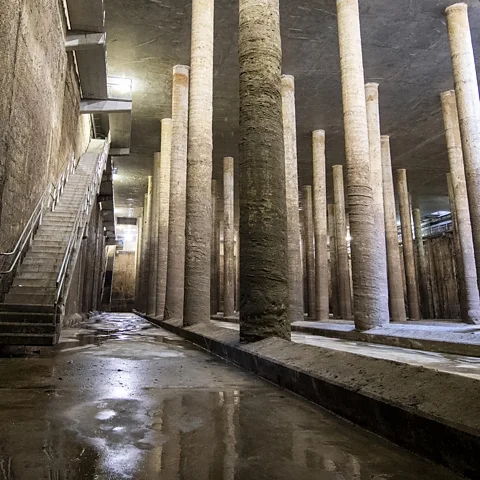 Barcelona Water Cycle, Barcelona City Council
Barcelona Water Cycle, Barcelona City CouncilSpain has a long history of flash floods. A large proportion of Catalonia's total rainfall is delivered by intense storms that gather in late summer. A single storm can easily deliver several months' worth of rain.
The intensity of the region's rainfall is due to a local weather phenomenon called a golpe frío – a cold drop – now known by the more precise term Depresión Aislada en Niveles Altos, or "Dana", describing an isolated, high-altitude depression. Warm, damp air rising from the Mediterranean encounters a mass of stagnant cold air at high altitudes, causing huge volumes of rain to suddenly precipitate.
Rising sea temperatures mean that the frequency and intensity of these storms is expected to increase. The floods that tore through Valencia in late October, leaving over 200 dead, were caused by a Dana event that delivered an entire year's worth of rain in a few hours. And these events are getting worse.
"The amount of precipitation that can be linked to these kinds of extreme episodes has increased," says Prohom. "We are facing a new challenge. It seems that climate change is acting more quickly than we expected."
Currently, meteorologists can give several days advance notice of a Dana event. But knowing exactly where and when the rain will fall is more difficult.
When it falls, the water too often has no opportunity to sink into soil. Flat and fertile, floodplains make attractive land for urban development, as well as agriculture. Urban sprawl spreads hard surfaces such as concrete and asphalt, preventing water soaking into the ground. Storm drains, culverts and embankments constructed to remedy the local flood risk simply move the problem downstream – in greater intensity. Changes in agricultural land, too, can impact the soil's ability to retain water.
"Many flood defence works are not a solution, but factors that are going to be aggravating the damage by increasing the speed and height of floodwaters," says Julia Martínez, executive director of the Foundation for a New Culture of Water, an independent research organisation based in Barcelona.
What's more, she says, by preventing small, more frequent floods, these defences encourage greater development within floodplains, magnifying the amount of damage that occurs when the defences are overcome.
Infrastructure in flood zones is built according to "return periods" that describe the maximum flood expected every 10, 100 or 500 years. But Martínez says these design parameters have failed to keep pace with a warming climate. "What we have now is a new climate. There is no infrastructure that can provide any safety to future events whose magnitude we cannot know."
In addition, as flood defences are costly, they also tend to exacerbate existing inequalities.
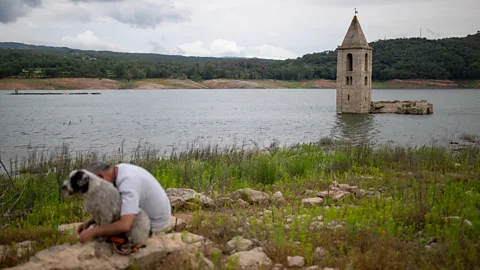 Getty Images
Getty ImagesNor has all this rain has alleviated the current drought crisis. Dana events tend to occur close to the coastline, while much of Barcelona's drinking water is generated by flows originating far north in the foothills of the Pyrenees. "Most of these big floods occur in areas where this water cannot accumulate," says Martínez. "They frequently occur in areas not suitable for dams, so we can have at the same time water scarcity and problems with flood events."
The cistern beneath Parc de Joan Miró is one of 13 such caverns hidden beneath the streets of Barcelona. But the rainwater collected here is not a drought relief measure, but part of a system to prevent stormwater overwhelming the city's drains. Once the rains subside, the water is released into the sewer system and flows to the sea.
Water – the presence or absence of it – is written into Barcelona's geography. La Rambla, the famed promenade running up from the harbour, comes from the Arabic ramla, describing the sandy riverbed that once marked the edge of the walled city. Beyond is the low plain of El Raval, whose long-vanished factories were once fed by rivulets running down nearby Montjuïc. Walk over Carrer de la Riereta (Stream Street) that runs through El Raval's centre, and you'll rise an invisible bank into Poble Sec (Dry Town).
Now, those watercourses have all vanished. Quenching the thirst of Barcelona's 1.6 million residents in a dense urban area is no easy task. The principal sources of water are the River Llobregat on the city's western margin, the Ser, a river almost 70km (43 miles) to the north, and a number of diminishing aquifers. These are increasingly insufficient to meet demand, particularly during drought years.
"Barcelona can boast that water consumption per inhabitant is much lower than that of comparable cities," says Fernando Cabello, director of water cycle services for the city authority, AMB. "However, it is expected that the increase in population and climate change will mean that water scarcity will continue to be a challenge."
Currently, a significant proportion of Barcelona's potential water budget is used simply to maintain the health of existing sources. Treated wastewater is piped upstream to maintain the flow of the River Llobregat, and purified wastewater is injected into the ground to prevent the Mediterranean intruding into the city's groundwater.
Following a drought emergency in 2008, Barcelona resolved to better secure its water supply. The most notable of the actions that follows was the Llobregat desalination plant, the largest in Europe. In 2021, it supplied 3% of Barcelona's drinking water. As the most recent drought took hold, one-third of Barcelona's water came from the desalination plant and a further 25% of drinking water came from regenerated water captured from the wastewater system, according to Cabello.
The Catalan Water Agency plans to invest €2.4bn ($2.5bn/£2bn) by 2027 to adapt to water scarcity and drought, including plans to build three more desalination plants in the region. "Work is being done so that, if necessary, 100% of drinking water can come from non-conventional resources, making the supply independent of the rainfall regime," Cabello says.
As well as increasing the supply, the city makes special efforts to minimise waste. The introduction of progressive tariffs incentivises households to use less water, making the most profligate users (typically households in wealthier neighbourhoods with gardens and pools) pay a premium. The city also has a secondary water network that supplies non-potable water – typically regenerated – for street cleaning, firefighters and park maintenance. Laws are being drafted that would require new housing and major renovations to install grey water systems that collect wastewater from showers and drains.
This wastewater is one of the great hopes for Barcelona's future supply. In Catalonia, wastewater treatment plants discharge large quantities of water into the sea – water that could otherwise be further treated and reused. Catalan authorities plan to build 25 water regeneration stations across the region to close the water cycle.
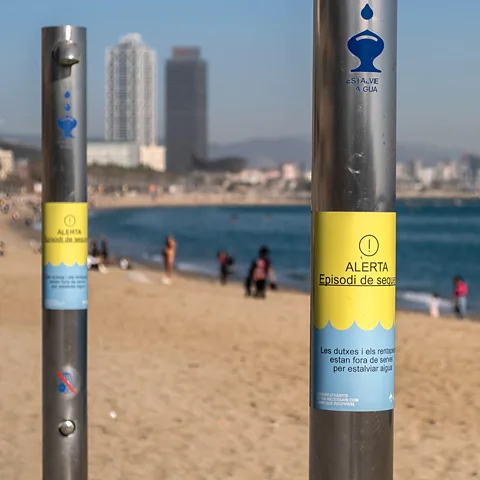 Getty Images
Getty ImagesMeeting the challenge of too much water is more difficult. "We are facing a situation where precipitation shows a decreasing trend [in the region], but the most significant shift we are observing is that precipitation is more concentrated in a lower number of events, and these events are more intense," says María José Polo Gómez, professor of hydraulic engineering at the University of Cordoba in Spain.
She says that events like that events like those in Valencia will continue to happen in the future, as long as human settlements keep encroaching onto floodplains. "We have protection measures in many rivers. But when you have such an extreme event, there is no dam that can protect you completely."
Authorities in Spain and beyond are increasingly looking to nature-based solutions that work with the natural water cycle instead of attempting to resist it. These include increasing the permeability of urbanised areas so that they soak up surface water in countries from New Zealand to the UK. This "sponge city" concept was enacted in Manchester's Gorton Park, where features such as swales, rain gardens, permeable paving, and tree pits help capture and reuse surface water that would otherwise overwhelm drain systems. (Read more about sponge cities.)
In Italy's Cinque Terre region, volunteers are repairing dry stone walls, helping to revive sustainable terraced agriculture that also works to slow water flows down the steep mountainsides. "Nature-based solutions will become more central to how we think about facing the challenges of extreme weather and climate change," says the project's junior project manager, Francesco Marchese.
However, the only guaranteed way to prevent death and destruction associated with flooding would be to move out of flood plains. Martínez argues that the homes and buildings destroyed by recent floods should not be rebuilt, with the public funds used instead to relocate families to safer areas.
Yet despite the dangers, municipalities continue to lobby for flood maps to be redrawn to allow for new construction in high-risk areas. "There are millions of euros of private benefits around urban projects, so there is a big pressure to build everywhere," says Martínez.
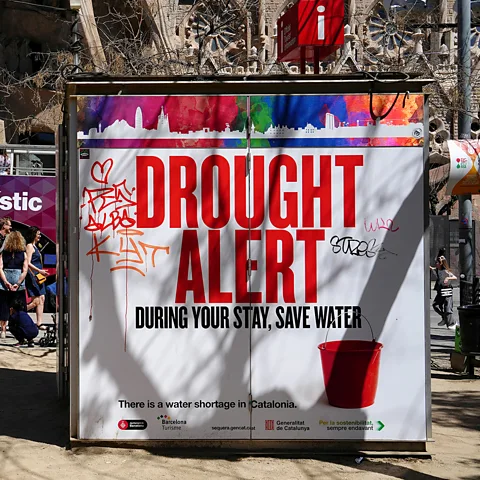 Getty Images
Getty ImagesValencian officials have been criticised for failing to issue warnings to the local population despite a forecast for intense rains. Of more than 500 Catalan municipalities that are required to have a flood emergency plan, less than half do, according to the Catalan News Agency, either because a plan is out of date, or was never drafted in the first place. After the autumn floods of 2024, government funding was announced to improve flood plans. Polo says it is vital that those living in flood zones are educated on the risks, so they know what to do in an emergency.
Carbon count
The emissions from travel it took to report this story were 0kg CO2. The digital emissions from this story are an estimated 1.2g to 3.6g CO2 per page view. Find out more about how we calculated this figure here.
In the face of a changing climate, Catalonia will have to consider the long-term viability of both urban and agricultural development. "In the past we've had floods, and we had drought, but these events are more frequent and more intense," says Prohom. "I think we have to change many things in our way of working."
In 2024, Catalonia's olive groves suffered a 50% drop in productivity. The Catalan Water Agency allocated an 80% cut in water for agriculture from February to May. Further afield, especially in the arid south, aquifers continue to shrink. "We have too much irrigated land in Spain," says Martínez. "We cannot be the supermarket of Europe. We have to be prepared and adapt urgently because things will get worse."
Polo agrees: "Now we have to rethink this model, because it's very likely that it is not sustainable in the future". Yet she is still hopeful. "We have been able to produce knowledge, and solutions based on knowledge. I am a scientist, and I trust our capacity to face these challenges."
--
For essential climate news and hopeful developments to your inbox, sign up to the Future Earth newsletter, while The Essential List delivers a handpicked selection of features and insights twice a week.
